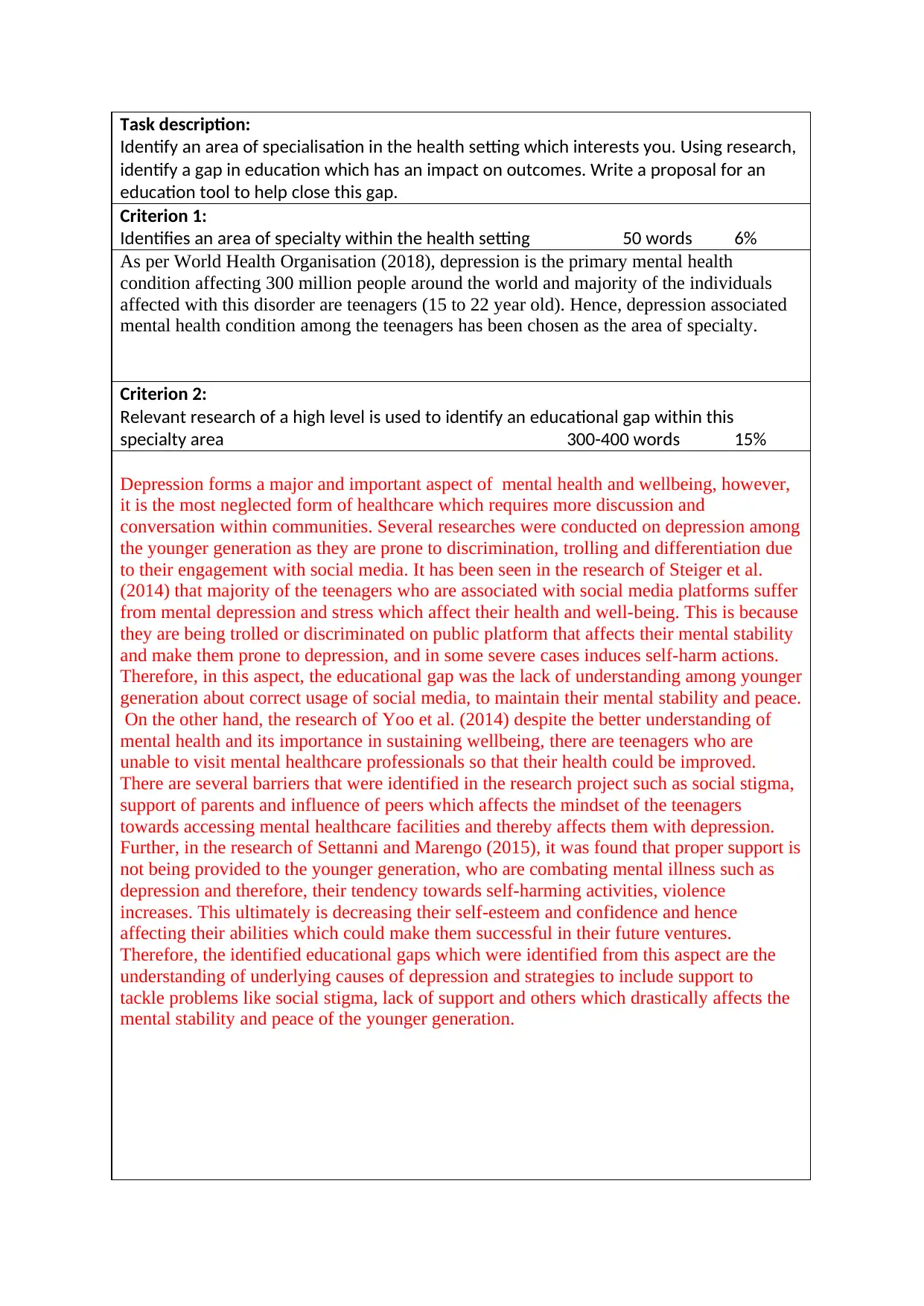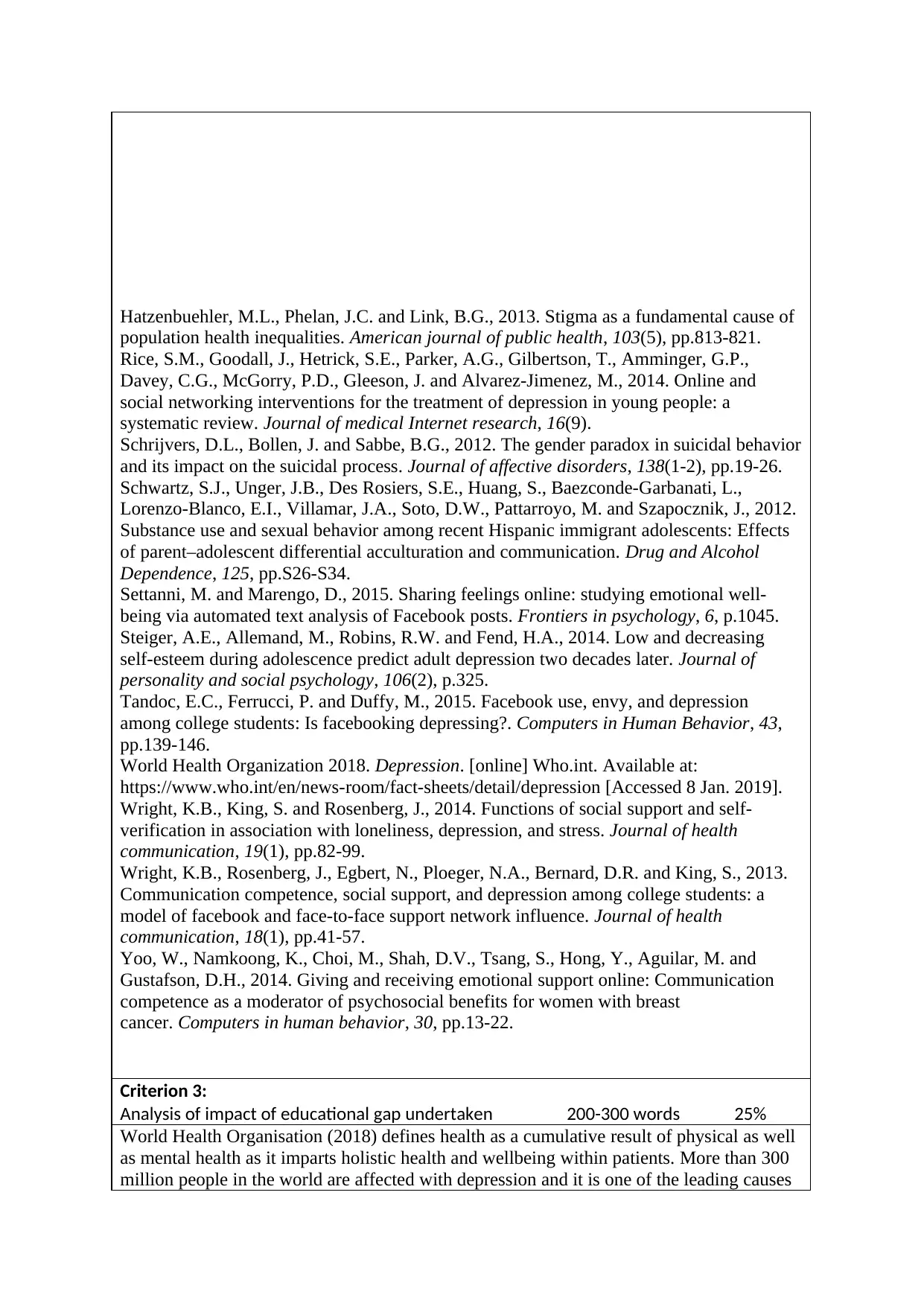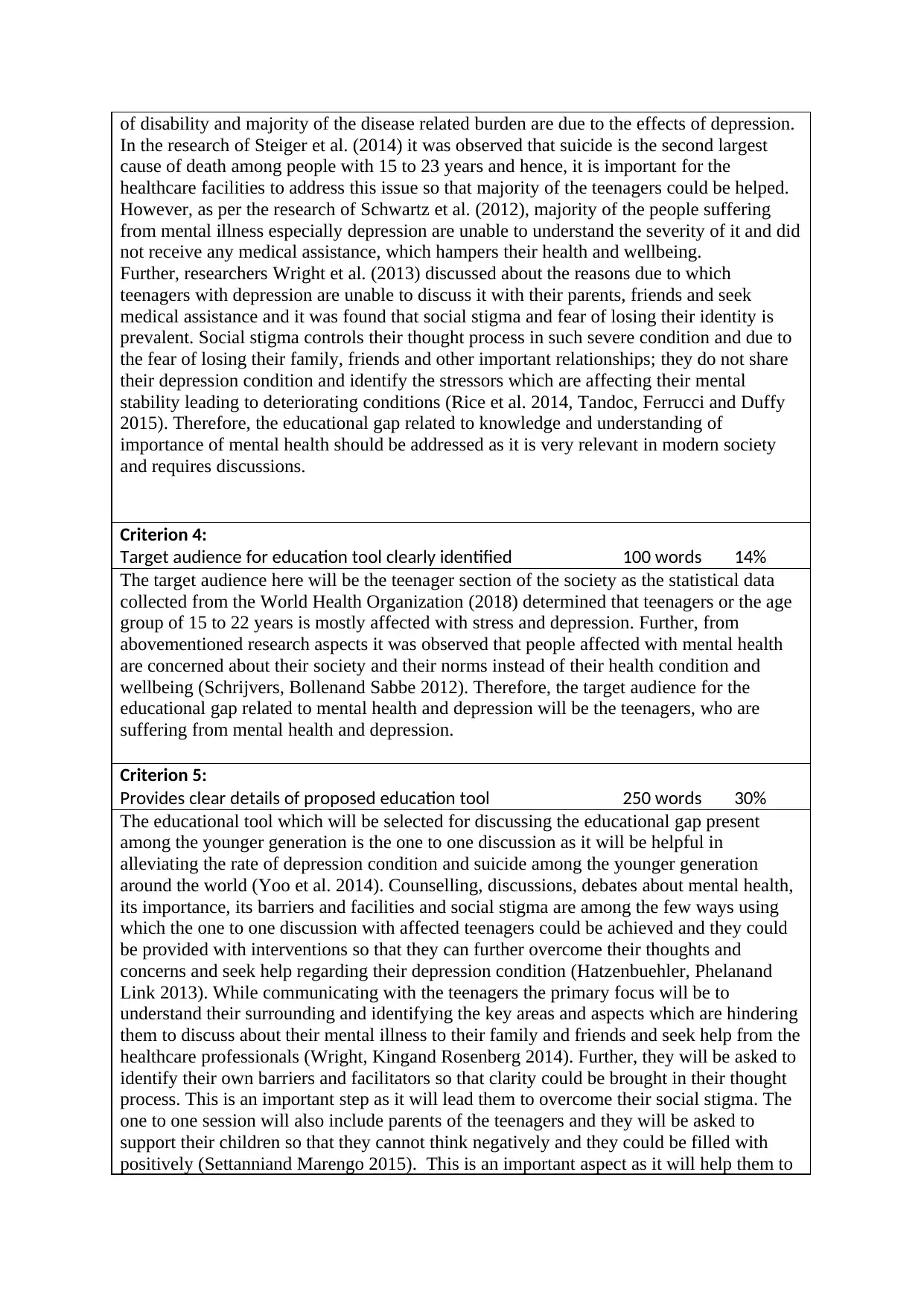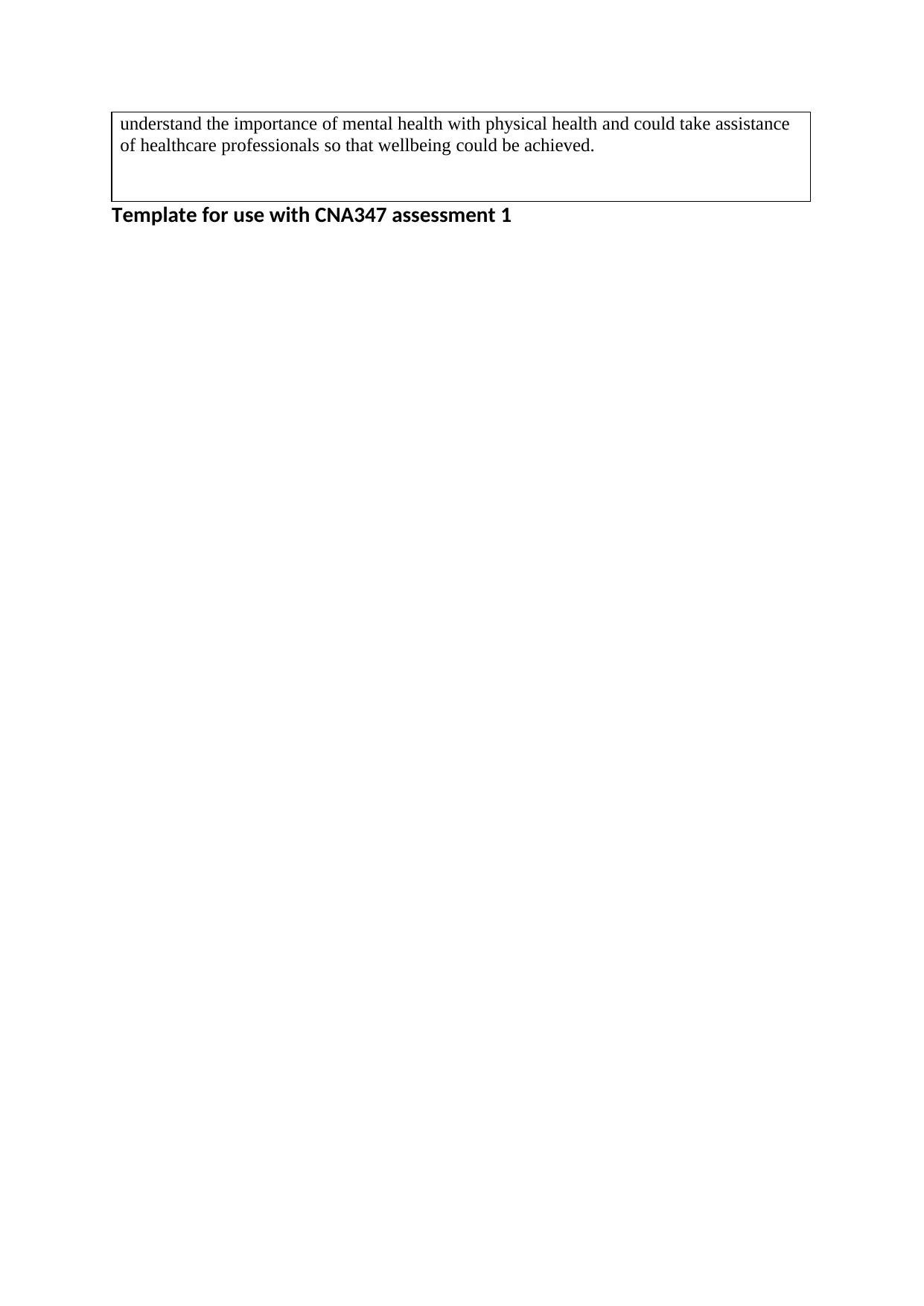Proposal for an Education Tool to Address the Educational Gap in Depression among Teenagers
VerifiedAdded on 2023/04/21
|4
|1808
|227
AI Summary
This proposal discusses the need for an education tool to address the educational gap in depression among teenagers. It identifies the area of specialty as depression among teenagers and highlights the impact of this educational gap on outcomes. The proposal also provides details of the proposed education tool, which includes one-on-one discussions and counseling sessions with affected teenagers and their parents.
Contribute Materials
Your contribution can guide someone’s learning journey. Share your
documents today.

Task description:
Identify an area of specialisation in the health setting which interests you. Using research,
identify a gap in education which has an impact on outcomes. Write a proposal for an
education tool to help close this gap.
Criterion 1:
Identifies an area of specialty within the health setting 50 words 6%
As per World Health Organisation (2018), depression is the primary mental health
condition affecting 300 million people around the world and majority of the individuals
affected with this disorder are teenagers (15 to 22 year old). Hence, depression associated
mental health condition among the teenagers has been chosen as the area of specialty.
Criterion 2:
Relevant research of a high level is used to identify an educational gap within this
specialty area 300-400 words 15%
Depression forms a major and important aspect of mental health and wellbeing, however,
it is the most neglected form of healthcare which requires more discussion and
conversation within communities. Several researches were conducted on depression among
the younger generation as they are prone to discrimination, trolling and differentiation due
to their engagement with social media. It has been seen in the research of Steiger et al.
(2014) that majority of the teenagers who are associated with social media platforms suffer
from mental depression and stress which affect their health and well-being. This is because
they are being trolled or discriminated on public platform that affects their mental stability
and make them prone to depression, and in some severe cases induces self-harm actions.
Therefore, in this aspect, the educational gap was the lack of understanding among younger
generation about correct usage of social media, to maintain their mental stability and peace.
On the other hand, the research of Yoo et al. (2014) despite the better understanding of
mental health and its importance in sustaining wellbeing, there are teenagers who are
unable to visit mental healthcare professionals so that their health could be improved.
There are several barriers that were identified in the research project such as social stigma,
support of parents and influence of peers which affects the mindset of the teenagers
towards accessing mental healthcare facilities and thereby affects them with depression.
Further, in the research of Settanni and Marengo (2015), it was found that proper support is
not being provided to the younger generation, who are combating mental illness such as
depression and therefore, their tendency towards self-harming activities, violence
increases. This ultimately is decreasing their self-esteem and confidence and hence
affecting their abilities which could make them successful in their future ventures.
Therefore, the identified educational gaps which were identified from this aspect are the
understanding of underlying causes of depression and strategies to include support to
tackle problems like social stigma, lack of support and others which drastically affects the
mental stability and peace of the younger generation.
Identify an area of specialisation in the health setting which interests you. Using research,
identify a gap in education which has an impact on outcomes. Write a proposal for an
education tool to help close this gap.
Criterion 1:
Identifies an area of specialty within the health setting 50 words 6%
As per World Health Organisation (2018), depression is the primary mental health
condition affecting 300 million people around the world and majority of the individuals
affected with this disorder are teenagers (15 to 22 year old). Hence, depression associated
mental health condition among the teenagers has been chosen as the area of specialty.
Criterion 2:
Relevant research of a high level is used to identify an educational gap within this
specialty area 300-400 words 15%
Depression forms a major and important aspect of mental health and wellbeing, however,
it is the most neglected form of healthcare which requires more discussion and
conversation within communities. Several researches were conducted on depression among
the younger generation as they are prone to discrimination, trolling and differentiation due
to their engagement with social media. It has been seen in the research of Steiger et al.
(2014) that majority of the teenagers who are associated with social media platforms suffer
from mental depression and stress which affect their health and well-being. This is because
they are being trolled or discriminated on public platform that affects their mental stability
and make them prone to depression, and in some severe cases induces self-harm actions.
Therefore, in this aspect, the educational gap was the lack of understanding among younger
generation about correct usage of social media, to maintain their mental stability and peace.
On the other hand, the research of Yoo et al. (2014) despite the better understanding of
mental health and its importance in sustaining wellbeing, there are teenagers who are
unable to visit mental healthcare professionals so that their health could be improved.
There are several barriers that were identified in the research project such as social stigma,
support of parents and influence of peers which affects the mindset of the teenagers
towards accessing mental healthcare facilities and thereby affects them with depression.
Further, in the research of Settanni and Marengo (2015), it was found that proper support is
not being provided to the younger generation, who are combating mental illness such as
depression and therefore, their tendency towards self-harming activities, violence
increases. This ultimately is decreasing their self-esteem and confidence and hence
affecting their abilities which could make them successful in their future ventures.
Therefore, the identified educational gaps which were identified from this aspect are the
understanding of underlying causes of depression and strategies to include support to
tackle problems like social stigma, lack of support and others which drastically affects the
mental stability and peace of the younger generation.
Secure Best Marks with AI Grader
Need help grading? Try our AI Grader for instant feedback on your assignments.

Hatzenbuehler, M.L., Phelan, J.C. and Link, B.G., 2013. Stigma as a fundamental cause of
population health inequalities. American journal of public health, 103(5), pp.813-821.
Rice, S.M., Goodall, J., Hetrick, S.E., Parker, A.G., Gilbertson, T., Amminger, G.P.,
Davey, C.G., McGorry, P.D., Gleeson, J. and Alvarez-Jimenez, M., 2014. Online and
social networking interventions for the treatment of depression in young people: a
systematic review. Journal of medical Internet research, 16(9).
Schrijvers, D.L., Bollen, J. and Sabbe, B.G., 2012. The gender paradox in suicidal behavior
and its impact on the suicidal process. Journal of affective disorders, 138(1-2), pp.19-26.
Schwartz, S.J., Unger, J.B., Des Rosiers, S.E., Huang, S., Baezconde-Garbanati, L.,
Lorenzo-Blanco, E.I., Villamar, J.A., Soto, D.W., Pattarroyo, M. and Szapocznik, J., 2012.
Substance use and sexual behavior among recent Hispanic immigrant adolescents: Effects
of parent–adolescent differential acculturation and communication. Drug and Alcohol
Dependence, 125, pp.S26-S34.
Settanni, M. and Marengo, D., 2015. Sharing feelings online: studying emotional well-
being via automated text analysis of Facebook posts. Frontiers in psychology, 6, p.1045.
Steiger, A.E., Allemand, M., Robins, R.W. and Fend, H.A., 2014. Low and decreasing
self-esteem during adolescence predict adult depression two decades later. Journal of
personality and social psychology, 106(2), p.325.
Tandoc, E.C., Ferrucci, P. and Duffy, M., 2015. Facebook use, envy, and depression
among college students: Is facebooking depressing?. Computers in Human Behavior, 43,
pp.139-146.
World Health Organization 2018. Depression. [online] Who.int. Available at:
https://www.who.int/en/news-room/fact-sheets/detail/depression [Accessed 8 Jan. 2019].
Wright, K.B., King, S. and Rosenberg, J., 2014. Functions of social support and self-
verification in association with loneliness, depression, and stress. Journal of health
communication, 19(1), pp.82-99.
Wright, K.B., Rosenberg, J., Egbert, N., Ploeger, N.A., Bernard, D.R. and King, S., 2013.
Communication competence, social support, and depression among college students: a
model of facebook and face-to-face support network influence. Journal of health
communication, 18(1), pp.41-57.
Yoo, W., Namkoong, K., Choi, M., Shah, D.V., Tsang, S., Hong, Y., Aguilar, M. and
Gustafson, D.H., 2014. Giving and receiving emotional support online: Communication
competence as a moderator of psychosocial benefits for women with breast
cancer. Computers in human behavior, 30, pp.13-22.
Criterion 3:
Analysis of impact of educational gap undertaken 200-300 words 25%
World Health Organisation (2018) defines health as a cumulative result of physical as well
as mental health as it imparts holistic health and wellbeing within patients. More than 300
million people in the world are affected with depression and it is one of the leading causes
population health inequalities. American journal of public health, 103(5), pp.813-821.
Rice, S.M., Goodall, J., Hetrick, S.E., Parker, A.G., Gilbertson, T., Amminger, G.P.,
Davey, C.G., McGorry, P.D., Gleeson, J. and Alvarez-Jimenez, M., 2014. Online and
social networking interventions for the treatment of depression in young people: a
systematic review. Journal of medical Internet research, 16(9).
Schrijvers, D.L., Bollen, J. and Sabbe, B.G., 2012. The gender paradox in suicidal behavior
and its impact on the suicidal process. Journal of affective disorders, 138(1-2), pp.19-26.
Schwartz, S.J., Unger, J.B., Des Rosiers, S.E., Huang, S., Baezconde-Garbanati, L.,
Lorenzo-Blanco, E.I., Villamar, J.A., Soto, D.W., Pattarroyo, M. and Szapocznik, J., 2012.
Substance use and sexual behavior among recent Hispanic immigrant adolescents: Effects
of parent–adolescent differential acculturation and communication. Drug and Alcohol
Dependence, 125, pp.S26-S34.
Settanni, M. and Marengo, D., 2015. Sharing feelings online: studying emotional well-
being via automated text analysis of Facebook posts. Frontiers in psychology, 6, p.1045.
Steiger, A.E., Allemand, M., Robins, R.W. and Fend, H.A., 2014. Low and decreasing
self-esteem during adolescence predict adult depression two decades later. Journal of
personality and social psychology, 106(2), p.325.
Tandoc, E.C., Ferrucci, P. and Duffy, M., 2015. Facebook use, envy, and depression
among college students: Is facebooking depressing?. Computers in Human Behavior, 43,
pp.139-146.
World Health Organization 2018. Depression. [online] Who.int. Available at:
https://www.who.int/en/news-room/fact-sheets/detail/depression [Accessed 8 Jan. 2019].
Wright, K.B., King, S. and Rosenberg, J., 2014. Functions of social support and self-
verification in association with loneliness, depression, and stress. Journal of health
communication, 19(1), pp.82-99.
Wright, K.B., Rosenberg, J., Egbert, N., Ploeger, N.A., Bernard, D.R. and King, S., 2013.
Communication competence, social support, and depression among college students: a
model of facebook and face-to-face support network influence. Journal of health
communication, 18(1), pp.41-57.
Yoo, W., Namkoong, K., Choi, M., Shah, D.V., Tsang, S., Hong, Y., Aguilar, M. and
Gustafson, D.H., 2014. Giving and receiving emotional support online: Communication
competence as a moderator of psychosocial benefits for women with breast
cancer. Computers in human behavior, 30, pp.13-22.
Criterion 3:
Analysis of impact of educational gap undertaken 200-300 words 25%
World Health Organisation (2018) defines health as a cumulative result of physical as well
as mental health as it imparts holistic health and wellbeing within patients. More than 300
million people in the world are affected with depression and it is one of the leading causes

of disability and majority of the disease related burden are due to the effects of depression.
In the research of Steiger et al. (2014) it was observed that suicide is the second largest
cause of death among people with 15 to 23 years and hence, it is important for the
healthcare facilities to address this issue so that majority of the teenagers could be helped.
However, as per the research of Schwartz et al. (2012), majority of the people suffering
from mental illness especially depression are unable to understand the severity of it and did
not receive any medical assistance, which hampers their health and wellbeing.
Further, researchers Wright et al. (2013) discussed about the reasons due to which
teenagers with depression are unable to discuss it with their parents, friends and seek
medical assistance and it was found that social stigma and fear of losing their identity is
prevalent. Social stigma controls their thought process in such severe condition and due to
the fear of losing their family, friends and other important relationships; they do not share
their depression condition and identify the stressors which are affecting their mental
stability leading to deteriorating conditions (Rice et al. 2014, Tandoc, Ferrucci and Duffy
2015). Therefore, the educational gap related to knowledge and understanding of
importance of mental health should be addressed as it is very relevant in modern society
and requires discussions.
Criterion 4:
Target audience for education tool clearly identified 100 words 14%
The target audience here will be the teenager section of the society as the statistical data
collected from the World Health Organization (2018) determined that teenagers or the age
group of 15 to 22 years is mostly affected with stress and depression. Further, from
abovementioned research aspects it was observed that people affected with mental health
are concerned about their society and their norms instead of their health condition and
wellbeing (Schrijvers, Bollenand Sabbe 2012). Therefore, the target audience for the
educational gap related to mental health and depression will be the teenagers, who are
suffering from mental health and depression.
Criterion 5:
Provides clear details of proposed education tool 250 words 30%
The educational tool which will be selected for discussing the educational gap present
among the younger generation is the one to one discussion as it will be helpful in
alleviating the rate of depression condition and suicide among the younger generation
around the world (Yoo et al. 2014). Counselling, discussions, debates about mental health,
its importance, its barriers and facilities and social stigma are among the few ways using
which the one to one discussion with affected teenagers could be achieved and they could
be provided with interventions so that they can further overcome their thoughts and
concerns and seek help regarding their depression condition (Hatzenbuehler, Phelanand
Link 2013). While communicating with the teenagers the primary focus will be to
understand their surrounding and identifying the key areas and aspects which are hindering
them to discuss about their mental illness to their family and friends and seek help from the
healthcare professionals (Wright, Kingand Rosenberg 2014). Further, they will be asked to
identify their own barriers and facilitators so that clarity could be brought in their thought
process. This is an important step as it will lead them to overcome their social stigma. The
one to one session will also include parents of the teenagers and they will be asked to
support their children so that they cannot think negatively and they could be filled with
positively (Settanniand Marengo 2015). This is an important aspect as it will help them to
In the research of Steiger et al. (2014) it was observed that suicide is the second largest
cause of death among people with 15 to 23 years and hence, it is important for the
healthcare facilities to address this issue so that majority of the teenagers could be helped.
However, as per the research of Schwartz et al. (2012), majority of the people suffering
from mental illness especially depression are unable to understand the severity of it and did
not receive any medical assistance, which hampers their health and wellbeing.
Further, researchers Wright et al. (2013) discussed about the reasons due to which
teenagers with depression are unable to discuss it with their parents, friends and seek
medical assistance and it was found that social stigma and fear of losing their identity is
prevalent. Social stigma controls their thought process in such severe condition and due to
the fear of losing their family, friends and other important relationships; they do not share
their depression condition and identify the stressors which are affecting their mental
stability leading to deteriorating conditions (Rice et al. 2014, Tandoc, Ferrucci and Duffy
2015). Therefore, the educational gap related to knowledge and understanding of
importance of mental health should be addressed as it is very relevant in modern society
and requires discussions.
Criterion 4:
Target audience for education tool clearly identified 100 words 14%
The target audience here will be the teenager section of the society as the statistical data
collected from the World Health Organization (2018) determined that teenagers or the age
group of 15 to 22 years is mostly affected with stress and depression. Further, from
abovementioned research aspects it was observed that people affected with mental health
are concerned about their society and their norms instead of their health condition and
wellbeing (Schrijvers, Bollenand Sabbe 2012). Therefore, the target audience for the
educational gap related to mental health and depression will be the teenagers, who are
suffering from mental health and depression.
Criterion 5:
Provides clear details of proposed education tool 250 words 30%
The educational tool which will be selected for discussing the educational gap present
among the younger generation is the one to one discussion as it will be helpful in
alleviating the rate of depression condition and suicide among the younger generation
around the world (Yoo et al. 2014). Counselling, discussions, debates about mental health,
its importance, its barriers and facilities and social stigma are among the few ways using
which the one to one discussion with affected teenagers could be achieved and they could
be provided with interventions so that they can further overcome their thoughts and
concerns and seek help regarding their depression condition (Hatzenbuehler, Phelanand
Link 2013). While communicating with the teenagers the primary focus will be to
understand their surrounding and identifying the key areas and aspects which are hindering
them to discuss about their mental illness to their family and friends and seek help from the
healthcare professionals (Wright, Kingand Rosenberg 2014). Further, they will be asked to
identify their own barriers and facilitators so that clarity could be brought in their thought
process. This is an important step as it will lead them to overcome their social stigma. The
one to one session will also include parents of the teenagers and they will be asked to
support their children so that they cannot think negatively and they could be filled with
positively (Settanniand Marengo 2015). This is an important aspect as it will help them to

understand the importance of mental health with physical health and could take assistance
of healthcare professionals so that wellbeing could be achieved.
Template for use with CNA347 assessment 1
of healthcare professionals so that wellbeing could be achieved.
Template for use with CNA347 assessment 1
1 out of 4
Your All-in-One AI-Powered Toolkit for Academic Success.
+13062052269
info@desklib.com
Available 24*7 on WhatsApp / Email
![[object Object]](/_next/static/media/star-bottom.7253800d.svg)
Unlock your academic potential
© 2024 | Zucol Services PVT LTD | All rights reserved.





